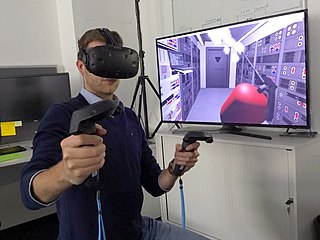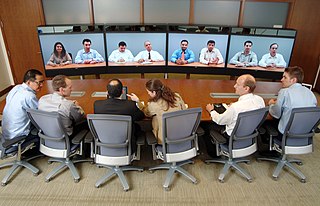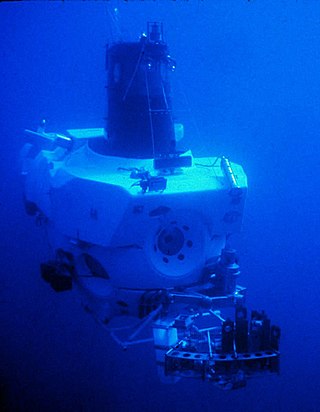
Virtual reality (VR) is a simulated experience that employs 3D near-eye displays and pose tracking to give the user an immersive feel of a virtual world. Applications of virtual reality include entertainment, education and business. VR is one of the key technologies in the reality-virtuality continuum. As such, it is different from other digital visualization solutions, such as augmented virtuality and augmented reality.

Motion sickness occurs due to a difference between actual and expected motion. Symptoms commonly include nausea, vomiting, cold sweat, headache, dizziness, tiredness, loss of appetite, and increased salivation. Complications may rarely include dehydration, electrolyte problems, or a lower esophageal tear.

Telepresence is the appearance or sensation of a person being present at a place other than their true location, via telerobotics or video.

Computer-mediated reality refers to the ability to add to, subtract information from, or otherwise manipulate one's perception of reality through the use of a wearable computer or hand-held device such as a smartphone.
In perceptual psychology, a sensory cue is a statistic or signal that can be extracted from the sensory input by a perceiver, that indicates the state of some property of the world that the perceiver is interested in perceiving.
Augmented cognition is an interdisciplinary area of psychology and engineering, attracting researchers from the more traditional fields of human-computer interaction, psychology, ergonomics and neuroscience. Augmented cognition research generally focuses on tasks and environments where human–computer interaction and interfaces already exist. Developers, leveraging the tools and findings of neuroscience, aim to develop applications which capture the human user's cognitive state in order to drive real-time computer systems. In doing so, these systems are able to provide operational data specifically targeted for the user in a given context. Three major areas of research in the field are: Cognitive State Assessment (CSA), Mitigation Strategies (MS), and Robust Controllers (RC). A subfield of the science, Augmented Social Cognition, endeavours to enhance the "ability of a group of people to remember, think, and reason."

In virtual reality (VR), immersion is the perception of being physically present in a non-physical world. The perception is created by surrounding the user of the VR system in images, sound or other stimuli that provide an engrossing total environment.
The sopite syndrome is a neurological disorder that relates symptoms of fatigue, drowsiness, and mood changes to prolonged periods of motion. The sopite syndrome has been attributed to motion-induced drowsiness such as that experienced by a baby when rocked. Researchers Ashton Graybiel and James Knepton at the US Naval Aerospace Medical Research Laboratory first used the term "the sopite syndrome" in 1976, to refer to the sometimes sole manifestation of motion sickness, though other researchers have referred to it as "Sopite syndrome."
James J. Kay was an ecological scientist and policy-maker. He was a respected physicist best known for his theoretical work on complexity and thermodynamics.
Presence is a theoretical concept describing the extent to which media represent the world. Presence is further described by Matthew Lombard and Theresa Ditton as “an illusion that a mediated experience is not mediated." Today, it often considers the effect that people experience when they interact with a computer-mediated or computer-generated environment. The conceptualization of presence borrows from multiple fields including communication, computer science, psychology, science, engineering, philosophy, and the arts. The concept of presence accounts for a variety of computer applications and Web-based entertainment today that are developed on the fundamentals of the phenomenon, in order to give people the sense of, as Sheridan called it, “being there."
A projection augmented model is an element sometimes employed in virtual reality systems. It consists of a physical three-dimensional model onto which a computer image is projected to create a realistic looking object. Importantly, the physical model is the same geometric shape as the object that the PA model depicts.
Dylan Schmorrow is an American scientist and retired United States Defense Official. He is currently the chief scientist at Soar Technology, Inc.. He is a retired US Navy captain, and served as the deputy director of the Human Performance, Training, and BioSystems Research Directorate at the Office of the Assistant Secretary of Defense, Research & Engineering at Office of the Secretary of Defense. He was also specialty leader of the Aerospace Experimental Psychologist community and an acquisition professional in the Naval Acquisition Corps.
The Deployable Virtual Training Environment (DVTE) is a laptop based platform for a wide variety of training simulations in the USMC. TRASYS webArchived 2007-07-07 at the Wayback Machine. DVTE consists of two main components, the Combined Arms Network (CAN) and the Infantry Tool Kit (ITK). A typical DVTE suite consists of 32 laptops and a modified NVisor SX Head-mounted display (HMD).

Illusions of self-motion occur when one perceives bodily motion despite no movement taking place. One can experience illusory movements of the whole body or of individual body parts, such as arms or legs.
In computing, 3D interaction is a form of human-machine interaction where users are able to move and perform interaction in 3D space. Both human and machine process information where the physical position of elements in the 3D space is relevant.
Affective haptics is an area of research which focuses on the study and design of devices and systems that can elicit, enhance, or influence the emotional state of a human by means of sense of touch. The research field is originated with the Dzmitry Tsetserukou and Alena Neviarouskaya papers on affective haptics and real-time communication system with rich emotional and haptic channels. Driven by the motivation to enhance social interactivity and emotionally immersive experience of users of real-time messaging, virtual, augmented realities, the idea of reinforcing (intensifying) own feelings and reproducing (simulating) the emotions felt by the partner was proposed. Four basic haptic (tactile) channels governing our emotions can be distinguished:
- physiological changes
- physical stimulation
- social touch
- emotional haptic design.
The TreadPort Active Wind Tunnel is a unique immersive virtual environment that integrates locomotion interfaces with sensory cues such as visual, auditory, olfactory, radiant heat and wind display. The TPAWT augments the Sarcos Treadport consisting of the Cave automatic virtual environment(CAVE) with a subsonic wind tunnel built around the user environment, and adds wind to the virtual environment. The Treadport Active Wind Tunnel is one of the first virtual environments to include wind into the sensory experience of the user. Other systems considering wind display, directly use fans.
Virtual reality sickness occurs when exposure to a virtual environment causes symptoms that are similar to motion sickness symptoms. The most common symptoms are general discomfort, eye strain, headache, stomach awareness, nausea, vomiting, pallor, sweating, fatigue, drowsiness, disorientation, and apathy. Other symptoms include postural instability and retching. Common causes are low frame rate, input lag, and the vergence-accommodation-conflict.
Sensory tourism is a form of tourism, that caters for people with vision impairment. Those suffering from vision impairment face many difficulties based around mainstream tourism such as access to information, navigation, safety and the knowledge of others around them. This has caused the visionless members of society to travel much less than those with no vision impairment. Combining the theories behind tourism in terms of its psychology and its relation to the senses, an inclusive experience for the visually disabled was developed. Sensory tourism engages the physical and multi-sensory aspects of tourism, enhancing the tourism experience specifically for those with, but also benefitting those without vision impairment.

Underwater exploration is the exploration of any underwater environment, either by direct observation by the explorer, or by remote observation and measurement under the direction of the investigators. Systematic, targeted exploration is the most effective method to increase understanding of the ocean and other underwater regions, so they can be effectively managed, conserved, regulated, and their resources discovered, accessed, and used. Less than 10% of the ocean has been mapped in any detail, less has been visually observed, and the total diversity of life and distribution of populations is similarly obscure.






